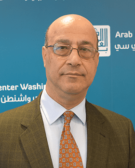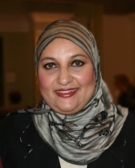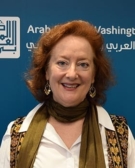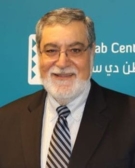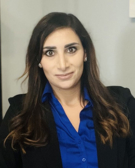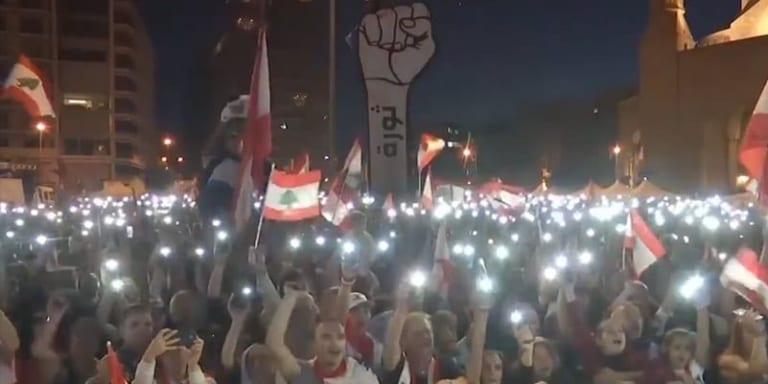
One of the remarkable developments of 2019 was a fresh wave of anti-government and anti-graft protests in Sudan, Algeria, Egypt, Iraq, and Lebanon, one that revived the hopes of the 2010-2011 Arab Spring that had been dormant because of counterrevolutions. Many Arabs participating in these protests for a better life––and many others looking on from the sidelines––as well as regional and international observers have speculated whether the new activism is another iteration of that spring. There certainly are many similarities to confirm this view; but there also are differences between the slogans and practices of the two periods which cannot be ignored.
To be sure, the slogans shouted by demonstrators in the five countries highlight a clear demand for political and socioeconomic changes that are no different from those heard in the first wave. However, there appear to be some important differences in the way demonstrators are voicing these slogans and how they are going about making them actionable, effective, sustainable, and eventually, successful. The results of the 2019 iteration have by no means become clear: Iraqi and Lebanese demonstrators still await the outcomes of their activism, those in Egypt have been forced to return to their homes by the repressive state, and those in Sudan and Algeria have achieved some success and moved away from initial agitation but still worry about being outmaneuvered.
In Palestine, the Palestinian Authority announced its intention to hold elections in the occupied territories after years of inaction on this essential instrument of democratic development. In fact, no street demonstrations demanding change in Palestinian public life prompted the announcement on elections, which remain uncertain because of domestic Palestinian considerations and others related to the Israeli occupation. But the development deserves attention. As does technology, which will play a role in both the Arab protests and their suppression by status quo forces in the Arab world.
Below, Arab Center Washington DC (ACW) research fellows and members of the ACW Academic Advisory Board respond to specific questions around the theme of “Prospects for Democratic Change in the Arab World in 2020” and provide their analyses and opinions.
What are the prospects for the full success of the Sudanese and Algerian changes of 2019?
Imad K. Harb, Director of Research, ACW
Sudan and Algeria witnessed sustained agitations for political change and government reform in 2019. In both countries, public pressure and protests were the essential factors that led to the ouster of Presidents Omar al-Bashir and Abdelaziz Bouteflika by their respective military institutions. The two men’s long tenures in power had bred corruption, economic difficulties, and political problems. Some argue that their ouster was inevitable considering the public pressure, but what hastened it were the decisions by the armed forces to end the presidents’ tenure in order to limit the damage Bashir and Bouteflika had inflicted on their respective countries and states and institutions.
Sudan today is in the midst of a transitional period in which there is acceptable cooperation between the political opposition and the military institution according to a political compromise reached in September 2019. New national elections are expected in 2022, but the current arrangement between civilians and the military is seen as the only possible accommodation short of a return to authoritarianism and repression. In 2020, it is expected that the two parties to this compromise will continue—amicably, yet cautiously—to manage their relations under difficult economic conditions and uncertain domestic and regional environments. They also will be trying to hold accountable the former regime personnel accused of transgressions. On the other hand, the protesters are likely to remain on the move to ascertain that the military establishment does not go back on its promise for a fruitful transitional period.
Algeria, on the other hand, and after a long period of time following the ouster of President Bouteflika, elected a new president, Abdelmadjid Tebboune, to manage a fraught political environment amid continuing protests. Those still in the streets rejected the military-controlled political process that led to electing Tebboune because they saw him as a mere extension of the Bouteflika regime. In 2020, Tebboune will have to gain the protesters’ trust and confidence by trying, first, to build a governing coalition that answers their demands for better governance and accountability, and second, to create an economic system that addresses the many problems besetting Algeria’s old rentier economic formula. His best bet will probably be to forge ahead with a constitutional reform process. Tebboune and the government he chooses may not have much time to make the necessary changes to the ossified system over which Bouteflika presided for twenty years.
How likely is change from authoritarianism in Egypt in 2020?
Sahar Khamis, University of Maryland; ACW Academic Advisory Board
The present Egyptian regime is unlike others that preceded it, which effectively deployed a “safety valve” mechanism by leaving a limited outlet for the Egyptian people to vent their grievances and to express their frustrations; indeed, the previous regimes hoped to prolong their autocratic rule by avoiding—or at least postponing—a total explosion of public anger. The current government of President Abdel-Fattah el-Sisi has total control of both the political and media landscapes, exercises a harsh crackdown on opposition, stifles freedoms, and disallows any type of “safety valve.” It is probable that such policies cannot allow a dictatorship to be sustained for a very long time, since completely closing off any outlets for dissent always leads to an explosion.
The unprecedented authoritarianism of the current Egyptian regime may very well pave the way for renewed protests. The eruption of the new waves of Arab Spring uprisings in several neighboring countries, many of which have included chants against Egypt’s current leader, will add their own pressure points on Egypt’s case. Additionally, the amplification of Egyptian opposition voices in exile, including not only activists but also whistleblowers in the diaspora who have become more emboldened lately and who have intensified their social media activism, will most likely pave the way for Egypt’s new wave of uprisings. The questions are how, when, and where will these uprisings most likely erupt, and with what direction, intensity, and outcome.
How possible are prospects for political change in Iraq after more than three months of demonstrations?
Abdulwahab Al-Qassab, Visiting Fellow, ACW
Political change in Iraq saw a real chance for success when Iraqis began a new wave of demonstrations in October 2019 demanding better living conditions, fighting corruption, and ending outside interference in the country’s affairs. Iraq has been living with a sectarian political system since the American invasion in 2003. The Shia in the country were urged by the marjaiyya (senior Shia clergy) to cast their ballots in elections for Shia political parties. The Sunnis voted for Sunni parties and the Kurds looked to support their Kurdish factions. This sectarian political atmosphere only divided Iraqis further and negatively impacted the national agenda of the country.
Fragmentation in the country increased during the reign of former Prime Minister Nouri al-Maliki, who presided over the breakdown of Iraqi democracy. The success of the Islamic State in controlling one-third of Iraq in 2014 added to that fragmentation, but it also allowed for Iran-supported militias and forces to gain more political power. The current conflict between Iran and the United States that is playing out in Iraq is likely to affect how Iraq sees itself in the coming year.
The dramatically divided scene has changed since October 2019, when Iraq’s youth began an uprising against corruption, economic failure, and Iranian interference. Members of this young generation freed themselves of sectarian discourses, ethnic divisions, and the militias’ corrupt control. They chanted Iraqi national songs calling for unity, justice, and democracy. Their aim was and remains to get rid of Iran’s intrusion in Iraqi internal affairs and to control their country’s destiny. They also intend to continue agitating for good governance, a democratic civil government with secular values, and a society free from sectarianism and ethnic divisions. Only time will tell how these protesters will deal with their hopes for a future Iraq while their country seems to be gripped by troubles between two other adversaries.
Will street activism in Lebanon lead to the desired political change in that country?
Laurie King, Georgetown University; ACW Academic Advisory Board
In a year that brought us gut-wrenching news from Yemen, Syria, the southern border of the United States, and the charred landscapes of California and Australia, reports of lively and peaceful demonstrations for dignity and democracy erupting in Khartoum, Baghdad, Beirut, and Algiers rekindled some of the Arab Spring’s embers of 2011. Although Lebanon did not figure in the news coverage of popular activism nine years ago, it would be a mistake to call Lebanon’s current protests the first flowerings of that nation’s Arab Spring. Lebanon experienced its first Arab Spring six years before Egypt, Syria, and Tunisia when huge crowds spilled into the streets of Beirut in February and March 2005 following the assassination of Prime Minister Rafiq Hariri and others in a massive car bombing. If democracy is characterized by people publicly and fearlessly expressing their desires for dignity, justice, equality, and liberty, then Lebanon today is indubitably a fertile site of democratization and political rebirth. Indeed, the protest movement that bloomed there last October is an even heartier variant of the popular movement of 2005.
The earlier protests focused on ending Syrian hegemony over Lebanon but did not address or resolve the chronic problems of governmental and business corruption or remove the straitjacket of confessionalism from the country’s governance system. And the protests of 2005 quickly split into two factions, one led by Hezbollah and its supporters, the other by a much looser and ill-defined coalition of parties and personages. The current protests in Lebanon are broader-based (in terms of social class, age, and ethnoreligious membership) and more resilient. They are also led by a generation of Lebanese who did not live the 1975-1990 war and who appear to have transcended the toxic and divisive confessional loyalties of their parents’ and grandparents’ generations. The old political guard’s grip on political discourse and possibilities is slipping away, dismissed and derided by the creative activism, humor, and passion of the protesters.
But Lebanon’s future is constrained by regional and internal dynamics—now more perilous after Donald Trump’s targeted killing of the Islamic Revolutionary Guard Corps’ Quds Force’s Major General Qassem Soleimani. The country’s dire financial situation is also a major factor. Repercussions of either or both of these constraints could still snuff out Lebanon’s dreams of dignity and democracy.
Do we expect to see agitation for political change in Palestine?
Khalil E. Jahshan, Executive Director, ACW
Since its inception in 2011, the Arab Spring has been essentially motivated by a list of common grievances shared by the population of large segments in the Arab world, including Tunisia, Syria, Yemen, Libya, Lebanon, Egypt, Iraq and Algeria, among others. The list of injustices ranged from the abuse of human and civil rights, the breakdown of social services, economic stagnation, and unaccountable authoritarian rulers, to widespread corruption among the ruling elites. Although limited progress has been reported by Tunisia, the same cannot be claimed by other restless countries throughout the region.
Palestine is a case in point where the population, despite its visible frustrations over long decades of rising expectations to end Israeli military occupation and establish an independent Palestinian state, has failed to generate its own Arab Spring in any significant manner. This led various analysts and practitioners to question the reasons for the lack of such a sustained effort in the West Bank and Gaza.
Public opinion polls in the West Bank and Gaza clearly show that a majority of Palestinians are frustrated with the continued Israeli occupation and the failure of the Palestinian leadership to end it and effect an independent alternative. Indeed, 61 percent would like President Mahmoud Abbas to resign. Yet despite their widespread frustration and the pessimistic outlook they hold toward the prospects for a just and lasting peace, thus far Palestinians have not seriously entertained the idea of a local Arab Spring in the occupied territories.
Four factors have historically contributed to this phenomenon. First, the protracted nature of the 71-year-old conflict has acquired a sense of permanence even in the minds of its victims. Second, ineffective Palestinian leadership lacks courage, determination, and strategic vision to mobilize the resources of the Palestinians in more productive directions. Third, a sophisticated but seemingly benign lifestyle under occupation has led to widespread apathy among a significant number of Palestinians who dropped their demand for change and replaced it with a survivalist strategy of acquiescence to endless occupation. And fourth, Palestinians lament their fast-growing and significant loss of trust in the international community, particularly the United States, both of which have abdicated their commitment to basic norms of international law and justice when it comes to Palestinian rights.
How will technology affect prospects for change in the Arab world in 2020?
Tamara Kharroub, ACW Assistant Executive Director and Senior Fellow
In the last decade, the possibilities of cyber warfare have become a reality in many contexts. In the Middle East in particular, existing conflicts, repression, and sectarian divides have been intensified by the utilization of technologies and social media tools. Cyberattacks and unconventional warfare have also become common tools in geopolitical battles.
While these cyber tools have been used as instruments of free expression and political organizing and debate at times, they are increasingly and predominantly becoming devices of control and manipulation. They remain confined by existing power structures whiles wealthy repressive governments are taking control of online spaces and digital platforms. According to a report by Freedom on the Net, internet freedom has declined globally in 2019 for the ninth consecutive year. Indeed, the last few years have seen new tactics of digital authoritarianism, including mass surveillance and cyber espionage, hacking of activists and dissidents, mass manipulation and disinformation campaigns and social media armies, hyperpolarization and incitement, policing of free expression online, shutting down services and platforms, cyberattacks, and foreign interference and cross-border influence operations.
Waves of protest movements in the Arab world and the prospects for democratization will be impacted by two major aspects of the cyber sphere in 2020 and the coming decade. The first is increasing, comprehensive, and centralized surveillance, where new tools such as face recognition databases and surveillance planes are already in use in some parts of the world. In this unregulated space, however, governments do not even have to resort to sophisticated hacking and espionage methods anymore or bypass or overcome encryption technologies. For example, Saudi Arabia used Twitter employees to gain access to information on critics and dissidents. The United Arab Emirates created the app ToTok––as an alternative to applications it banned in the country such as WhatsApp—in order to collect personal information on citizens who would willingly share their private data in order to use the app. The second factor influencing protest and political freedoms includes systematic and targeted online attack campaigns. For example, social media accounts of Lebanese activists were recently shut down as a result of structured targeted campaigns of mass reporting to force the closure of these accounts. It is becoming progressively easier and faster for those in power to create more avenues of control and to stifle dissent and target protesters.
With the development of Artificial Intelligence technologies, 5G networks, sophisticated biometric tracking, predictive policing, and the like, the year 2020 will witness more tools of repression and rights abuses in the hands of autocratic governments. Similarly, the year began with the US-Iran escalation of hostilities, which will most likely continue with unconventional weapons and in cyber space, bringing greater possibilities of a cyber third world war. But with the imminent danger of cyber warfare and the destructive potential of such low-cost yet maximum-damage weapons, 2020 will also see expanded debates and efforts to regulate this space, put pressure on the tech industry, hold governments accountable, and define the rules of engagement in the cyber sphere.

